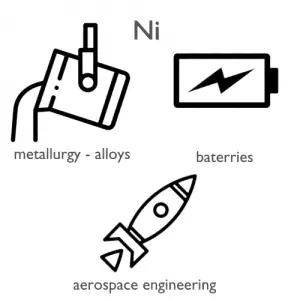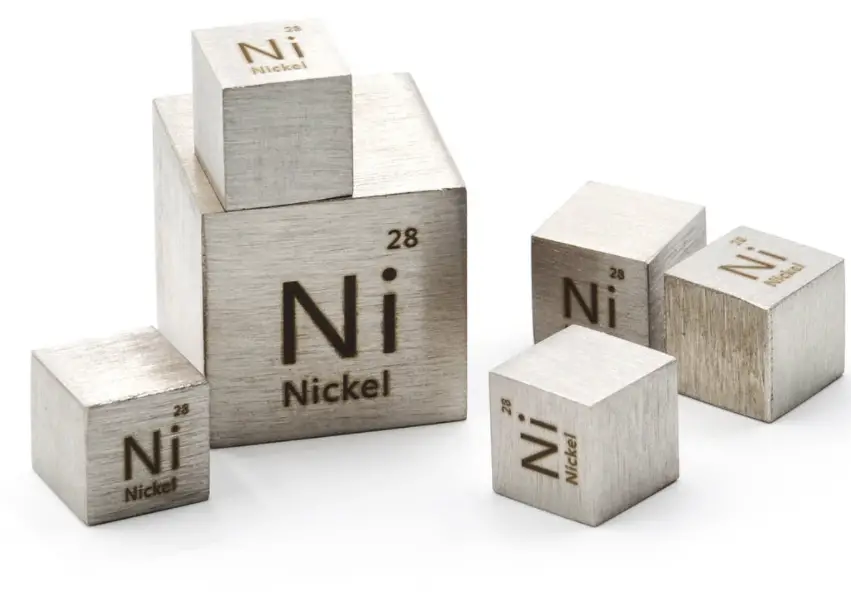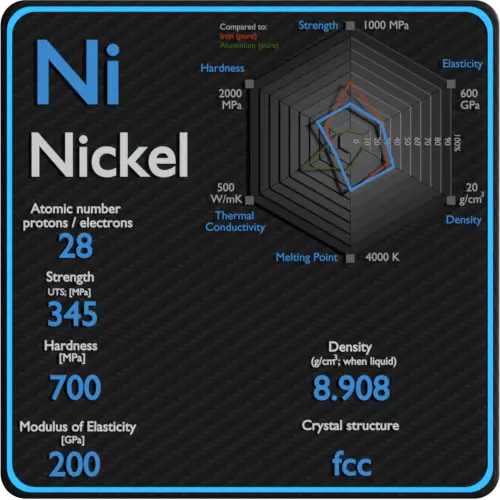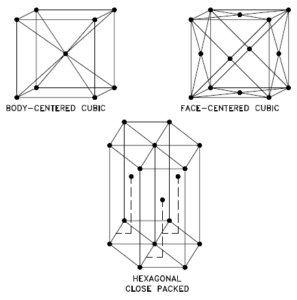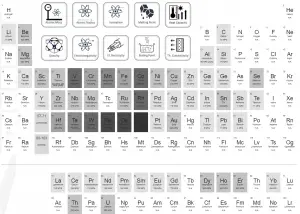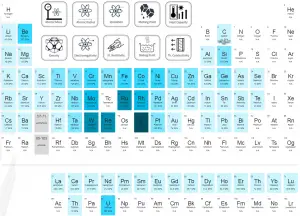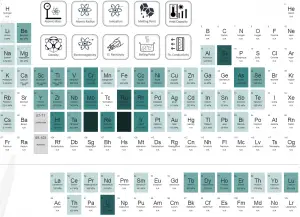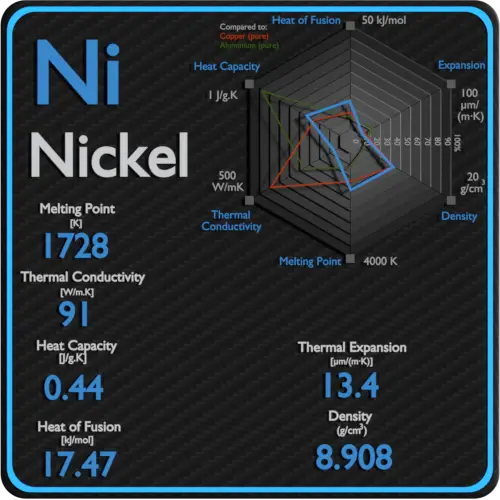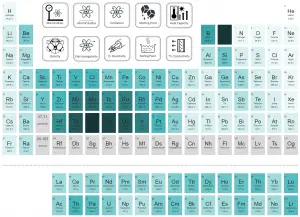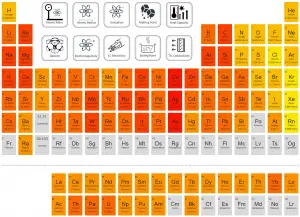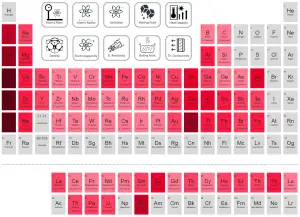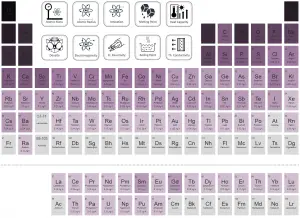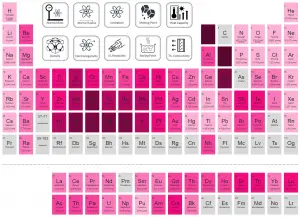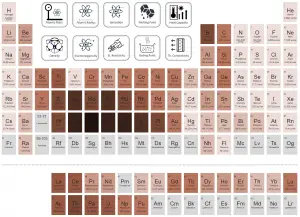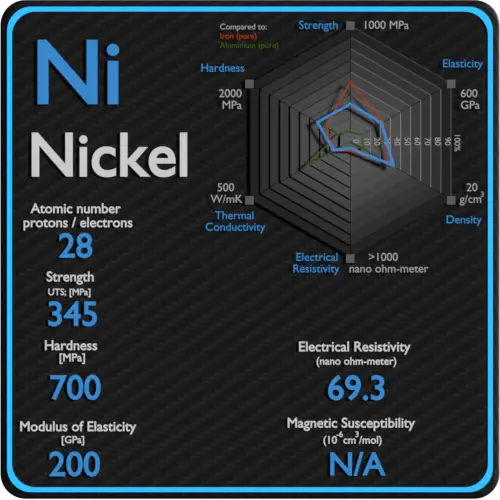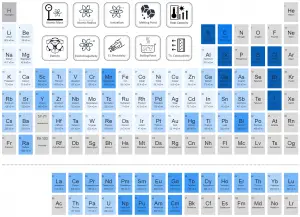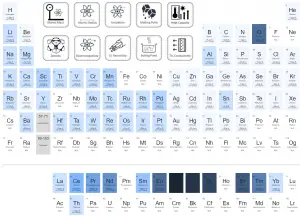About Nickel
Nickel is a silvery-white lustrous metal with a slight golden tinge. Nickel belongs to the transition metals and is hard and ductile.
Summary
| Element | Nickel |
| Atomic number | 28 |
| Element category | Transition Metal |
| Phase at STP | Solid |
| Density | 8.908 g/cm3 |
| Ultimate Tensile Strength | 345 MPa |
| Yield Strength | 70 MPa |
| Young’s Modulus of Elasticity | 200 GPa |
| Mohs Scale | 4 |
| Brinell Hardness | 700 MPa |
| Vickers Hardness | 640 MPa |
| Melting Point | 1455 °C |
| Boiling Point | 2730 °C |
| Thermal Conductivity | 90.7 W/mK |
| Thermal Expansion Coefficient | 13.4 µm/mK |
| Specific Heat | 0.44 J/g K |
| Heat of Fusion | 17.47 kJ/mol |
| Heat of Vaporization | 370.4 kJ/mol |
| Electrical resistivity [nanoOhm meter] | 69.3 |
| Magnetic Susceptibility | N/A |
Applications of Nickel
The global production of nickel is presently used as follows: 68% in stainless steel; 10% in nonferrous alloys; 9% in electroplating; 7% in alloy steel; 3% in foundries; and 4% other uses (including batteries). Nickel is used as a constituent of different types of alloys; for instance, Monel (corrosion resistant material), Nichrome (an alloy used for resistance heating elements), Permalloy (an alloy with high magnetic permeability at low field strength and low hysteresis loss), cupro-nickel, stainless steel, nickel silver, etc. Nickel based alloys (e.g. Fe-Cr-Ni(Mo) alloys) alloys exhibit excellent ductility and toughness, even at high strength levels and these properties are retained up to low temperatures. Nickel and its alloys are highly resistant to corrosion in many environments, especially those that are basic (alkaline). Nickel also reduces thermal expansion for better dimensional stability. Nickel is the base element for superalloys. These metals have excellent resistance to thermal creep deformation and retain their stiffness, strength, toughness and dimensional stability at temperatures much higher than the other aerospace structural materials.
Production and Price of Nickel
Raw materials prices change daily. They are primarily driven by supply, demand and energy prices. In 2019, prices of pure Nickel were at around 77 $/kg.
Nickel is extracted by roasting to NiO and then reducing with carbon. The Mond process is used to manufacture pure nickel, in which impure nickel reacts with carbon monoxide (CO) to form Ni(CO)4, which is then decomposed at 200 °C to yield 99.99% Ni. More than 2.7 million tonnes (t) of nickel per year are estimated to be mined worldwide, with Indonesia (800,000 t), the Philippines (420,000 t), Russia (270,000 t), New Caledonia (220,000 t), Australia (180,000 t) and Canada (180,000 t) being the largest producers as of 2019.
Source: www.luciteria.com
Mechanical Properties of Nickel
Strength of Nickel
In mechanics of materials, the strength of a material is its ability to withstand an applied load without failure or plastic deformation. Strength of materials basically considers the relationship between the external loads applied to a material and the resulting deformation or change in material dimensions. In designing structures and machines, it is important to consider these factors, in order that the material selected will have adequate strength to resist applied loads or forces and retain its original shape. Strength of a material is its ability to withstand this applied load without failure or plastic deformation.
For tensile stress, the capacity of a material or structure to withstand loads tending to elongate is known as ultimate tensile strength (UTS). Yield strength or yield stress is the material property defined as the stress at which a material begins to deform plastically whereas yield point is the point where nonlinear (elastic + plastic) deformation begins.
See also: Strength of Materials
Ultimate Tensile Strength of Nickel
Ultimate tensile strength of Nickel is 345 MPa.
Yield Strength of Nickel
Yield strength of Nickel is 70 MPa.
Modulus of Elasticity of Nickel
The Young’s modulus of elasticity of Nickel is 200 GPa.
Hardness of Nickel
In materials science, hardness is the ability to withstand surface indentation (localized plastic deformation) and scratching. Brinell hardness test is one of indentation hardness tests, that has been developed for hardness testing. In Brinell tests, a hard, spherical indenter is forced under a specific load into the surface of the metal to be tested.
Brinell hardness of Nickel is approximately 700 MPa.
The Vickers hardness test method was developed by Robert L. Smith and George E. Sandland at Vickers Ltd as an alternative to the Brinell method to measure the hardness of materials. The Vickers hardness test method can be also used as a microhardness test method, which is mostly used for small parts, thin sections, or case depth work.
Vickers hardness of Nickel is approximately 640 MPa.
Scratch hardness is the measure of how resistant a sample is to permanent plastic deformation due to friction from a sharp object. The most common scale for this qualitative test is Mohs scale, which is used in mineralogy. The Mohs scale of mineral hardness is based on the ability of one natural sample of mineral to scratch another mineral visibly.
Nickel is has a hardness of approximately 4.
See also: Hardness of Materials
Nickel – Crystal Structure
A possible crystal structure of Nickel is face-centered cubic structure.
In metals, and in many other solids, the atoms are arranged in regular arrays called crystals. A crystal lattice is a repeating pattern of mathematical points that extends throughout space. The forces of chemical bonding causes this repetition. It is this repeated pattern which control properties like strength, ductility, density, conductivity (property of conducting or transmitting heat, electricity, etc.), and shape. There are 14 general types of such patterns known as Bravais lattices.
See also: Crystal Structure of Materials
Crystal Structure of Nickel

Thermal Properties of Nickel
Nickel – Melting Point and Boiling Point
Melting point of Nickel is 1455°C.
Boiling point of Nickel is 2730°C.
Note that, these points are associated with the standard atmospheric pressure.
Nickel – Thermal Conductivity
Thermal conductivity of Nickel is 90.7 W/(m·K).
The heat transfer characteristics of a solid material are measured by a property called the thermal conductivity, k (or λ), measured in W/m.K. It is a measure of a substance’s ability to transfer heat through a material by conduction. Note that Fourier’s law applies for all matter, regardless of its state (solid, liquid, or gas), therefore, it is also defined for liquids and gases.
Coefficient of Thermal Expansion of Nickel
Linear thermal expansion coefficient of Nickel is 13.4 µm/(m·K)
Thermal expansion is generally the tendency of matter to change its dimensions in response to a change in temperature. It is usually expressed as a fractional change in length or volume per unit temperature change.
Nickel – Specific Heat, Latent Heat of Fusion, Latent Heat of Vaporization
Specific heat of Nickel is 0.44 J/g K.
Heat capacity is an extensive property of matter, meaning it is proportional to the size of the system. Heat capacity C has the unit of energy per degree or energy per kelvin. When expressing the same phenomenon as an intensive property, the heat capacity is divided by the amount of substance, mass, or volume, thus the quantity is independent of the size or extent of the sample.
Latent Heat of Fusion of Nickel is 17.47 kJ/mol.
Latent Heat of Vaporization of Nickel is 370.4 kJ/mol.
Latent heat is the amount of heat added to or removed from a substance to produce a change in phase. This energy breaks down the intermolecular attractive forces, and also must provide the energy necessary to expand the gas (the pΔV work). When latent heat is added, no temperature change occurs. The enthalpy of vaporization is a function of the pressure at which that transformation takes place.
Nickel – Electrical Resistivity – Magnetic Susceptibility
Electrical property refers to the response of a material to an applied electric field. One of the principal characteristics of materials is their ability (or lack of ability) to conduct electrical current. Indeed, materials are classified by this property, that is, they are divided into conductors, semiconductors, and nonconductors.
See also: Electrical Properties
Magnetic property refers to the response of a material to an applied magnetic field. The macroscopic magnetic properties of a material are a consequence of interactions between an external magnetic field and the magnetic dipole moments of the constituent atoms. Different materials react to the application of magnetic field differently.
See also: Magnetic Properties
Electrical Resistivity of Nickel
Electrical resistivity of Nickel is 69.3 nΩ⋅m.
Electrical conductivity and its converse, electrical resistivity, is a fundamental property of a material that quantifies how Nickel conducts the flow of electric current. Electrical conductivity or specific conductance is the reciprocal of electrical resistivity.
Magnetic Susceptibility of Nickel
Magnetic susceptibility of Nickel is N/A.
In electromagnetism, magnetic susceptibility is the measure of the magnetization of a substance. Magnetic susceptibility is a dimensionless proportionality factor that indicates the degree of magnetization of Nickel in response to an applied magnetic field.
Application and prices of other elements


